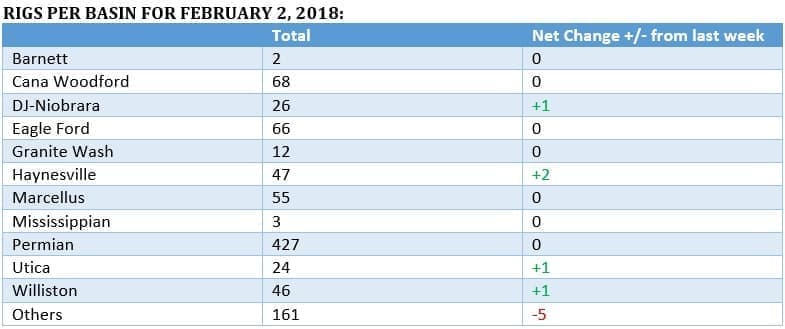The recent crash in the financial market has well and truly brought an end to the oil price rally, seriously hurting energy stocks in the process.

(Click to enlarge)

(Click to enlarge)

(Click to enlarge)

(Click to enlarge)
- China surpassed the U.S to become the world’s largest oil importer in 2017, averaging 8.4 million barrels per day (mb/d) of imports compared to just 7.9 mb/d for the U.S. China had already become the largest importer of petroleum and other liquid fuels in 2013.
- China’s demand continues to rise, but its imports are also elevated by China continuing to fill up its strategic petroleum reserve. Domestic oil production also fell sharply, accentuating China’s import dependence.
- Higher U.S. crude oil exports also lowered the net import figure last year.
Market Movers
- ExxonMobil (NYSE: XOM) received a double downgrade at Barclays. The investment bank lowered its outlook for Exxon’s shares from Overweight to Underweight.
- Midstates Petroleum (NYSE: MPO) has offered to merge with SandRidge Energy (NYSE: SD) in an all-stock deal. Shareholders of MPO would hold 40 percent of the combined company and SD shareholders would own 60 percent.
- Eni (NYSE: E) and Total SA (NYSE: TOT) reported a large gas discovery off the coast of Cyprus, the latest in a string of discoveries that could transform the Eastern Mediterranean into a major gas hub.
Tuesday February 6, 2018
The major news over the last few days is the global market meltdown, which has inflicted disproportionate pain on the energy sector. Equities sold off around the world, but energy stocks dropped especially severely. Falling oil prices and a rebound in the U.S. dollar magnified the losses in the energy space. As of early trading on Tuesday, the losses continued.
Energy stocks plunge. The Energy Select Sector SPDR ETF, an exchange-traded fund that tracks the energy sector, lost 4.31 percent on Monday, the largest one-day decline since January 2016. The fund has lost more than 10 percent in two days. The losses mirror those at individual companies. ExxonMobil (NYSE: XOM) saw its share price plunge by more than 10 percent between Friday and Monday. The oil major was hit on two fronts as poor earnings came on the same day that markets started melting down. Barclays gave Exxon a double downgrade. "This is contagious from the financial markets and the equity market, especially,” Michael Lynch, president of Strategic Energy & Economic Research, told Bloomberg. "People worry that the demand may be not as robust over the next couple of quarters as people have been anticipating.”
Hedge funds hit pause button on oil futures. Ahead of the market meltdown, hedge funds and other money managers trimmed their bullish bets on oil futures, the first cut in net-long bets in six weeks. The reduction was small, but it was an indication that investors were growing wary last week of the oil price rally. Meanwhile, since that data release, global equities have sold off. That risks a deeper liquidation of bullish bets on crude oil, which could send prices careening down. Related: Maduro Proposes OPEC Cryptocurrency
U.S. ban on Venezuelan oil? U.S. Secretary of State Rex Tillerson floated the idea of a ban on Venezuelan oil imports into the U.S., a drastic move that would send shockwaves through a country already dealing with falling oil production and an economic crisis. American refiners would also be hit. Valero Energy (NYSE: VLO) and Chevron (NYSE: CVX) would be impacted the most, the first and second largest U.S. buyers of Venezuelan oil. They have refineries on the Gulf Coast that would be negatively affected, a fact not lost on the U.S. government.
Halliburton battles Schlumberger for fracking patents. Bloomberg reports that Halliburton (NYSE: HAL) is trying to convince U.S. patent authorities that Schlumberger (NYSE: SLB) is using repackaged Halliburton technology, justifying a cancellation of some patents. “They’re the two big dogs in the space,” said J. David Anderson, an analyst at Barclays, according to Bloomberg. “Halliburton and Schlumberger have been battling for that top spot in North American services for a decade, so the fact they’re going after each other with patents is not surprising.”
Banks increase oil price forecasts. A Wall Street Journal survey of 15 investment banks finds that the banks are revising up their predictions for oil prices for the year. The average forecast for Brent prices in 2018 jumped to $61 per barrel, according to a January survey, up $3 per barrel from a month earlier.
Permian with 500,000 bpd of spare capacity. The Permian rivals Saudi Arabia in terms of spare capacity, at least according to Nansen Saleri, former head of reservoir management at Saudi Aramco. He pegged spare capacity in the Permian at 500,000 bpd, which is about a third of the 1.5 mb/d of Saudi Arabia. “For decades there was one country and one company that had spare capacity and that country was Saudi Arabia and that company was Saudi Aramco,” Saleri said, according to Bloomberg. “Now we are seeing an analog to that in the Permian.” He argues that Permian drillers can ramp up output in just a few days, faster than anywhere except Saudi Arabia.
Oil majors disappoint in fourth quarter earnings. Lower downstream earnings due to shrinking margins contributed to a wave of disappointing figures from the oil majors. ExxonMobil (NYSE: XOM) and Chevron (NYSE: CVX) missed earnings expectations by a wide margin, while Royal Dutch Shell (NYSE: RDS.A) and BP (NYSE: BP) fared better.
ExxonMobil acknowledges peak demand scenario. ExxonMobil (NYSE: XOM) said in a securities filing that the effect of climate change regulations and policies could lead to a decline of oil demand by 20 percent by 2040. The filing came in response to a 2017 shareholder resolution calling on the company to assess the risks of climate change to its business. Meanwhile, the oil major also laid out a scenario in which demand grows by 20 percent over the same timeframe, a vastly different outcome that the company says it is using for its business decisions.
Related: Most Big Banks Are Now Bullish On Oil
OPEC to overshoot? S&P Global Platts estimates that global oil inventories are mostly drained down to average levels, a conclusion echoed recently by a report from Goldman Sachs. Data is murky and is often published on a several-month lag, which could add to the danger that OPEC tightens the market too much. Head of S&P Global Platts Analytics, Chris Midgley, said that the seasonal dip in demand could mean that oil prices do not spike until the second half of the year.
EIA estimates of shale growth “extremely optimistic.” A new report from the Post Carbon Institute analyzed thousands of shale wells and concluded that the EIA’s assumptions about the long-term production potential of U.S. shale are “highly to extremely optimistic, and are therefore very unlikely to be realized.” The report said that depletion will force shale drillers outside of core areas, and even there, it will be difficult to keep production elevated for the next several decades, as the EIA assumes.
More Top Reads From Oilprice.com:
- Oil Prices Ravaged By Financial Turmoil
- U.S. Considers Cutting Venezuelan Oil Imports
- Will Rising Crude Inventories End The Rally?



















Two days ago they were talking about how high oil prices could rise and projecting prices of $70-$80/barrel in 2018. Now the talk is about how the financial markets meltdown has brought an end to the oil price rally.
Oil prices don’t exist in isolation. Like everything else, they are affected by market forces and any volatility in the financial markets. But Mr Tom Kool is wrong to jump the gun and claim that the oil price rally is over. That is a very unsound conclusion.
The very positive global oil market fundamentals that two days ago were underpinning the upward surge of the oil price and the re-balancing in the oil market are still there and they will continue to support an oil price ranging from $70-$75/barrel in 2018. This can only change if the Wall Street bubble bursts with very adverse impact on the global economy as was the case in 2008.
As for the report from the Post Carbon Institute describing EIA estimates of shale oil growth “extremely optimistic (a code word for hype), many international oil and energy experts (me included) have recognized a long while ago that claims by the EIA and the IEA about exaggerated increases of shale oil production and rises in US oil inventories as mostly hype. The most important recruit to this view is the Saudi oil minister, Mr Khalid Al Falih, who publicly accused the IEA in Davos of hyping about US shale oil.
Dr Mamdouh G Salameh
International Oil Economist
Visiting Professor of Energy Economics at ESCP Europe Business School, London